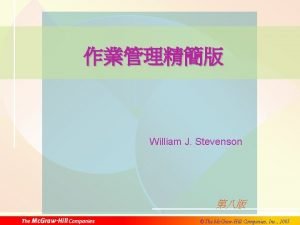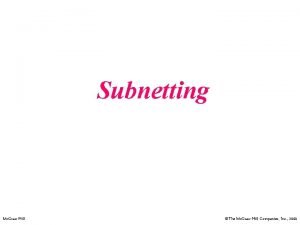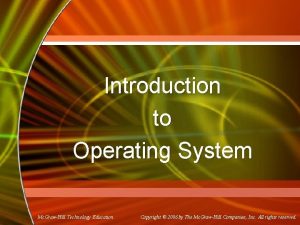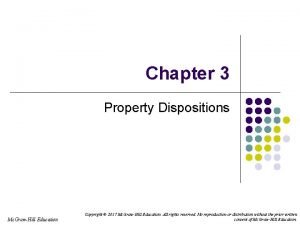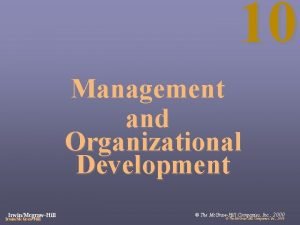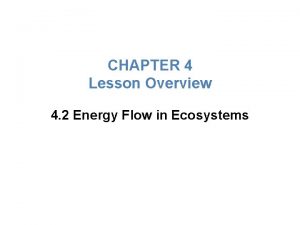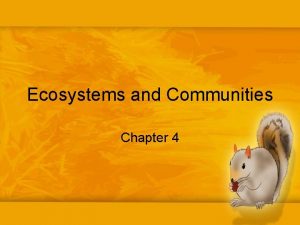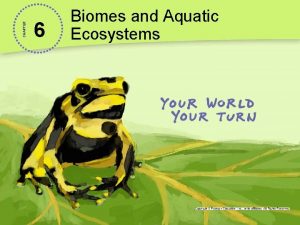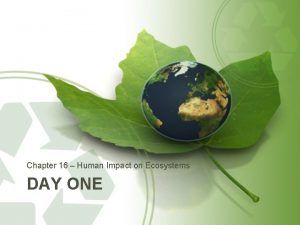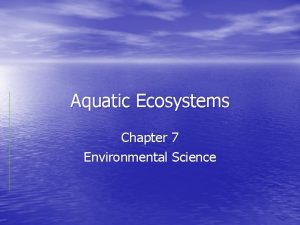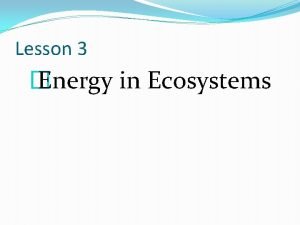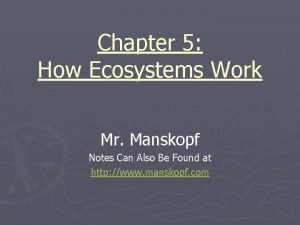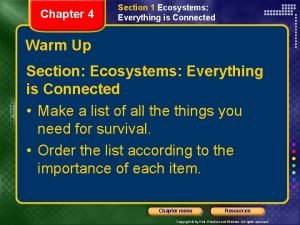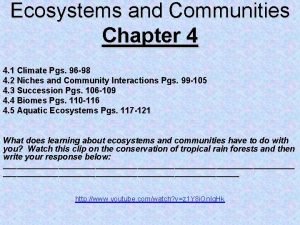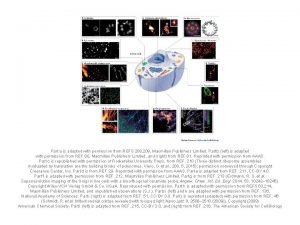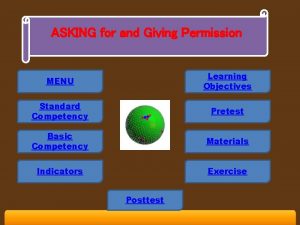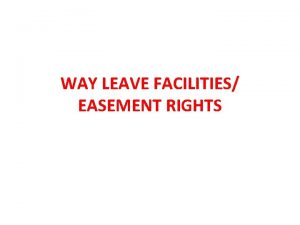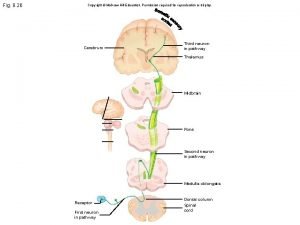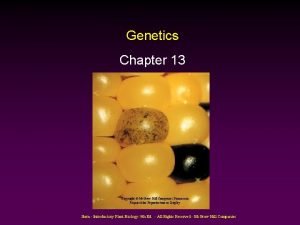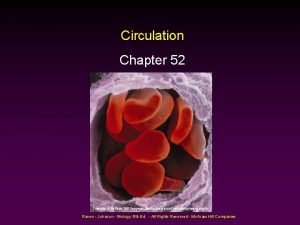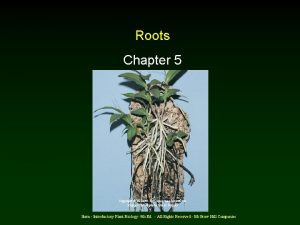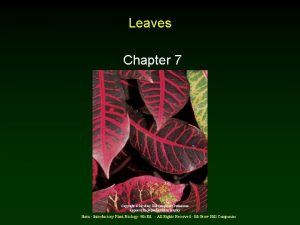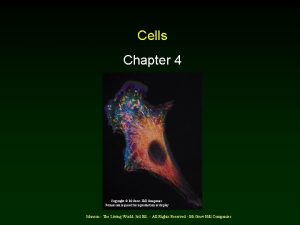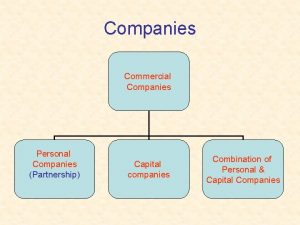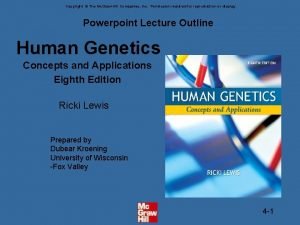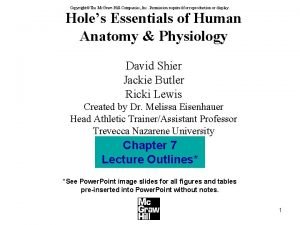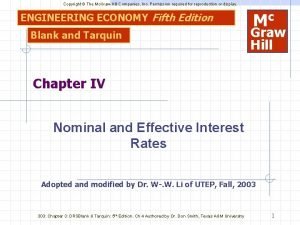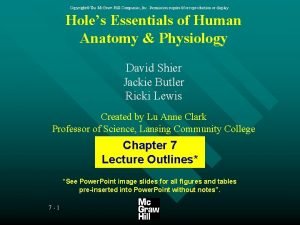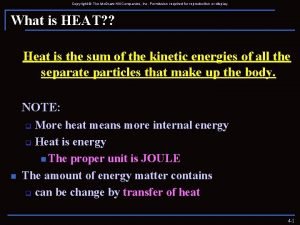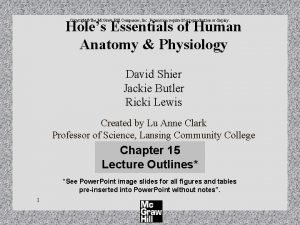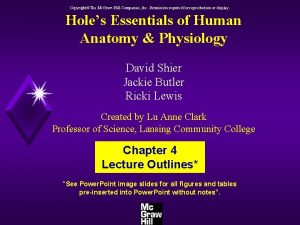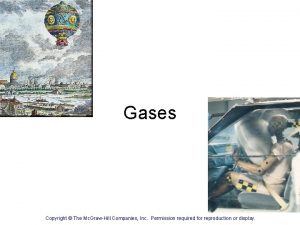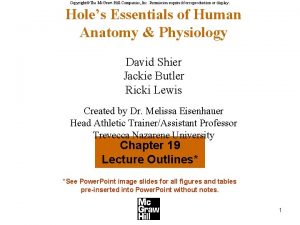Ecosystems Chapter 29 Copyright Mc GrawHill Companies Permission














































- Slides: 46

Ecosystems Chapter 29 Copyright © Mc. Graw-Hill Companies Permission required for reproduction or display Johnson - The Living World: 3 rd Ed. - All Rights Reserved - Mc. Graw Hill Companies

Outline • • • Trophic Levels Energy Flows Through Ecosystems Water Cycle Mineral Cycles Atmospheric Circulation Ocean Ecosystems Freshwater Ecosystems Land Ecosystems Johnson - The Living World: 3 rd Ed. - All Rights Reserved - Mc. Graw Hill Companies

Trophic Levels • • Ecology - Study of interactions of living organisms with one another and their physical environment. Community - Collection of all species inhabiting an area. Habitat - Place where an organism lives. Ecosystem - Largely self-sustaining collection of organisms and their physical environment. Johnson - The Living World: 3 rd Ed. - All Rights Reserved - Mc. Graw Hill Companies

Trophic Levels • Energy flows into biological world from sun. v Producers capture and transform sunlight into chemical energy through photosynthesis. v Consumers obtain energy by consuming plants or other animals. Johnson - The Living World: 3 rd Ed. - All Rights Reserved - Mc. Graw Hill Companies

Trophic Levels • Trophic Level is a feeding level composed of all organisms within an ecosystem feeding at the same energy level. v Food Chain - Food energy passes through ecosystem from one level to another in a linear path. v Food Web - Path of energy flow is composed of multiple linear chains as a predator may eat more than one kind of prey. Johnson - The Living World: 3 rd Ed. - All Rights Reserved - Mc. Graw Hill Companies

Trophic Levels Johnson - The Living World: 3 rd Ed. - All Rights Reserved - Mc. Graw Hill Companies

Trophic Levels • • • Producers - Use solar energy to build energy -rich sugar molecules. Herbivores - Eat plants v Primary Consumers Carnivores - Eat animals v Secondary Consumers Omivores - Eat Plants and animals. Detritivores and Decomposers - Obtain energy from organic wastes and dead bodies. (Bacteria and Fungi) Johnson - The Living World: 3 rd Ed. - All Rights Reserved - Mc. Graw Hill Companies

Energy Flows Through Ecosystems • • Primary Productivity - Total amount of light energy converted to organic compounds in a given area per unit time. Net Primary Productivity - Total amount of energy fixed by photosynthesis per unit time, minus energy expended by metabolic activities of ecosystem organisms. v Biomass - Total weight of all ecosystem organisms. Johnson - The Living World: 3 rd Ed. - All Rights Reserved - Mc. Graw Hill Companies

Energy Flows Through Ecosystems • Approximately one order of magnitude of energy is lost as you move from one trophic level to the next. v Terrestrial food chains generally limited to four trophic levels. Johnson - The Living World: 3 rd Ed. - All Rights Reserved - Mc. Graw Hill Companies

Ecological Pyramids • Successive members of a food chain incorporate about 10% of the available energy of organisms they consume. v Far more individuals at lower trophic levels than at higher levels. - Explains small population sizes of top carnivores. v Some aquatic ecosystems have inverted biomass pyramids. Johnson - The Living World: 3 rd Ed. - All Rights Reserved - Mc. Graw Hill Companies

Ecological Pyramids Johnson - The Living World: 3 rd Ed. - All Rights Reserved - Mc. Graw Hill Companies

Water Cycle • • Environmental Water Cycle v Atmospheric water vapor condenses and falls to earth’s surface. - Heated by sun and reenters atmosphere by evaporation. Organismic Water Cycle v Surface water taken up by plant roots, and reenters atmosphere by transpiration from leaf surfaces. Johnson - The Living World: 3 rd Ed. - All Rights Reserved - Mc. Graw Hill Companies

Environmental Water Cycle Copyright © Mc. Graw-Hill Companies Permission required for reproduction or display Johnson - The Living World: 3 rd Ed. - All Rights Reserved - Mc. Graw Hill Companies

Water Cycle • • Organismic water cycle is broken when forests are cut down and transpiration levels dramatically decline. Groundwater v In US, groundwater provides about 25% of total water, and provides drinking water to about 50% of the population. - Slow recharge rate and chemical pollutants are making groundwater an increasingly serious problem. Johnson - The Living World: 3 rd Ed. - All Rights Reserved - Mc. Graw Hill Companies

Carbon Cycle • • Plants uptake carbon dioxide through photosynthesis and produce glucose. Organisms eat plant bodies, and incorporate carbon into their own tissue. Most organisms extract energy from their food source and release carbon dioxide as a by-product (Respiration). Carbon trapped in fossil fuels is released to atmosphere when the fuel is burned (Combustion). Johnson - The Living World: 3 rd Ed. - All Rights Reserved - Mc. Graw Hill Companies

Carbon Cycle Johnson - The Living World: 3 rd Ed. - All Rights Reserved - Mc. Graw Hill Companies

Nitrogen Cycle • • Most organisms are unable to utilize atmospheric nitrogen (N 2). v Triple covalent bond very difficult to break. Some bacteria can break the triple bond and bind nitrogen atoms to hydrogen forming ammonia (NH 3). - Nitrogen Fixation v Plant growth is often severely limited by availability of “fixed” nitrogen in the soil. Johnson - The Living World: 3 rd Ed. - All Rights Reserved - Mc. Graw Hill Companies

Nitrogen Cycle Copyright © Mc. Graw-Hill Companies Permission required for reproduction or display Johnson - The Living World: 3 rd Ed. - All Rights Reserved - Mc. Graw Hill Companies

Phosphorus Cycle • • Key component of ATP and DNA. Often in very limited supply in soil. No atmospheric form. v Most exists as calcium phosphate. Low phosphorous levels in freshwater lakes prevent large algal growths. v Eutrophication - Build up of excessive nutrients, often from human inputs. Johnson - The Living World: 3 rd Ed. - All Rights Reserved - Mc. Graw Hill Companies

Phosphorus Cycle Copyright © Mc. Graw-Hill Companies Permission required for reproduction or display Johnson - The Living World: 3 rd Ed. - All Rights Reserved - Mc. Graw Hill Companies

Atmospheric Circulation • • • As you move from the equator to temperate latitudes, sunlight strikes the earth at more oblique angles. Earth’s daily rotation cycle dictates that climate at any given latitude is relatively constant. Earth’s annual orbit and tilted axis dictate all regions away from the equator experience a progression of seasons. Johnson - The Living World: 3 rd Ed. - All Rights Reserved - Mc. Graw Hill Companies

Latitude Affects Climate Copyright © Mc. Graw-Hill Companies Permission required for reproduction or display Johnson - The Living World: 3 rd Ed. - All Rights Reserved - Mc. Graw Hill Companies

Atmospheric Circulation • Major atmospheric circulation patterns result from interactions between six large air masses. v At equator, warm air rises, cools, and drops rain forming tropical rainforests near the equator. - Air masses continue to drop moisture as they move north and south. By the time they reach 30 degrees north and south latitude, they are dry, and thus form most of the world’s major deserts. Johnson - The Living World: 3 rd Ed. - All Rights Reserved - Mc. Graw Hill Companies

Air Circulation Cells Johnson - The Living World: 3 rd Ed. - All Rights Reserved - Mc. Graw Hill Companies

Latitude and Elevation • • Temperatures are higher in tropical areas due to increased sunlight. v Solar radiation is most intense at equator. Ecological consequences of elevational temperature variation mimic those of latitudinal temperature variation. - In North America, a 1, 000 m increase in elevation results in same temperature drop as 880 km increase in latitude. Johnson - The Living World: 3 rd Ed. - All Rights Reserved - Mc. Graw Hill Companies

Effect of Elevation on Ecosystems Johnson - The Living World: 3 rd Ed. - All Rights Reserved - Mc. Graw Hill Companies

Latitude and Elevation • Rain Shadows v Moving body of air must move upward as it encounters a mountain. - Cools and condenses, dropping precipitation on windward side. - Air mass descends and warms on the leeward side, absorbs much of the available moisture, and often produces a desert. Johnson - The Living World: 3 rd Ed. - All Rights Reserved - Mc. Graw Hill Companies

Patterns of Ocean Circulation • Ocean circulation determined by atmospheric circulation and location of land masses. Johnson - The Living World: 3 rd Ed. - All Rights Reserved - Mc. Graw Hill Companies

Patterns of Ocean Circulation • El Nino Southern Oscillation v Pacific Ocean normally fanned by constant east-west trade winds. - Push warm surface water away from eastern coastal areas, and allows cold, nutrient-rich, water to well up. Ø If winds slacken, warm water moves back inward, cutting off nutrient supply. § Commercial fishing off Peru and Chile decreases dramatically. Johnson - The Living World: 3 rd Ed. - All Rights Reserved - Mc. Graw Hill Companies

Patterns of Ocean Circulation v Weather systems shifted eastward. - Previously rainy areas left in drought. Ø Effects propagated across world. Johnson - The Living World: 3 rd Ed. - All Rights Reserved - Mc. Graw Hill Companies

Ocean Ecosystems • Shallow Waters v Most large commercial fisheries located in coastal regions. - Intertidal Region - Exposed to air when tides recede. - Estuaries - Union of rivers and coastal bays. Ø Intermediate salinity Ø Very high nutrient levels Johnson - The Living World: 3 rd Ed. - All Rights Reserved - Mc. Graw Hill Companies

Ocean Ecosystems • • Open Sea Surface v Majority of ocean surface accounted for by open sea. - Most plankton occur in top 100 m of sea due to sunlight penetration. Deep Sea Waters v Very little light penetrates past 300 m. v Hydrothermal vents support localized populations of organisms. Johnson - The Living World: 3 rd Ed. - All Rights Reserved - Mc. Graw Hill Companies

Ocean Ecosystems • More than 90% of all described species of organisms occur on land. v Each large group of organisms has marine representative, but these comprise only a small fraction of described species. - Barriers sharper on land favoring natural selection. - Few deep-sea taxonomists. v Most major phyla originated in the sea, and still have deep sea representatives. Johnson - The Living World: 3 rd Ed. - All Rights Reserved - Mc. Graw Hill Companies

Freshwater Ecosystems • • Inland lakes cover 1. 8% of earth’s surface, while rivers and streams cover 0. 3%. Lakes divided into two categories: v Eutrophic - Rich in nutrients and organic matter. v Oligotrophic - Poor in nutrients and organic matter. - Often deeper than eutrophic lakes, and very susceptible to chemical pollutants. Johnson - The Living World: 3 rd Ed. - All Rights Reserved - Mc. Graw Hill Companies

Freshwater Ecosystems • Thermal Stratification o v Process whereby water at 4 C sinks beneath warmer or cooler water. o - In winter 4 water sinks below cooler water that later freezes over. Ø In spring, ice melts and surface water warms to 4 o and sinks, bringing nutrient -rich cooler water to the surface. § Spring Overturn Johnson - The Living World: 3 rd Ed. - All Rights Reserved - Mc. Graw Hill Companies

Freshwater Ecosystems v In summer, warmer water forms layer over cooler water, forming an abrupt thermocline. - In autumn, surface water temperature drops until it reaches temperature of cooler water underneath. Ø Upper and lower layers mix. § Fall Overturn Johnson - The Living World: 3 rd Ed. - All Rights Reserved - Mc. Graw Hill Companies

Spring and Fall Overturns Johnson - The Living World: 3 rd Ed. - All Rights Reserved - Mc. Graw Hill Companies

Land Ecosystems • Biome - Terrestrial ecosystem that occurs over a broad area and characterized by a particular climate and defined group of organisms. Johnson - The Living World: 3 rd Ed. - All Rights Reserved - Mc. Graw Hill Companies

Earth’s Biomes Johnson - The Living World: 3 rd Ed. - All Rights Reserved - Mc. Graw Hill Companies

Land Ecosystems • Seven Major Biomes v Tropical Rain Forests - Over 250 cm annual rainfall. - Contain at least half earth’s terrestrial plant and animal species. v Savannas - Season rainfall (75 -125 cm annually). - Dry tropical grassland transitioning from tropical rainforests to deserts. Johnson - The Living World: 3 rd Ed. - All Rights Reserved - Mc. Graw Hill Companies

Land Ecosystems Deserts - Less than 25 cm annual rainfall. - Plants and animals adapted for water conservation. v Grasslands - Highly productive temperate regions. - Herds of grazing mammals. v Johnson - The Living World: 3 rd Ed. - All Rights Reserved - Mc. Graw Hill Companies

Land Ecosystems Deciduous Hardwoods - Mild climate with plentiful rainfall. - Trees drop leaves in winter. v Taiga - Long cold winter. - Coniferous trees. v Johnson - The Living World: 3 rd Ed. - All Rights Reserved - Mc. Graw Hill Companies

Land Ecosystems v Tundra - Open, windswept, and boggy. - Permafrost (permanent ice) exists within a meter of the surface. Johnson - The Living World: 3 rd Ed. - All Rights Reserved - Mc. Graw Hill Companies

Land Ecosystems • Other Biomes v Chaparral v Polar Ice v Mountain Zone v Temperate Evergreen Forest v Warm, Moist Evergreen Forest v Tropical Monsoon Forest v Semidesert Johnson - The Living World: 3 rd Ed. - All Rights Reserved - Mc. Graw Hill Companies

Review • • • Trophic Levels Energy Flows Through Ecosystems Water Cycle Mineral Cycles Atmospheric Circulation Ocean Ecosystems Freshwater Ecosystems Land Ecosystems Johnson - The Living World: 3 rd Ed. - All Rights Reserved - Mc. Graw Hill Companies

Copyright © Mc. Graw-Hill Companies Permission required for reproduction or display Johnson - The Living World: 3 rd Ed. - All Rights Reserved - Mc. Graw Hill Companies
 Grawhill
Grawhill Grawhill
Grawhill Grawhill
Grawhill Grawhill
Grawhill Mc grawhill
Mc grawhill Mc grawhill
Mc grawhill Grawhill
Grawhill Mc grawhill
Mc grawhill Grawhill
Grawhill Section 3 aquatic ecosystems worksheet answers
Section 3 aquatic ecosystems worksheet answers Chapter 4 lesson 2 energy flow in ecosystems
Chapter 4 lesson 2 energy flow in ecosystems Ecosystems and communities chapter 4 answer key
Ecosystems and communities chapter 4 answer key Epiphytes plants
Epiphytes plants Biomes and aquatic ecosystems
Biomes and aquatic ecosystems Chapter 55 ecosystems and restoration ecology
Chapter 55 ecosystems and restoration ecology Chapter 42 ecosystems and energy
Chapter 42 ecosystems and energy Chapter 3 lesson 3 biomes and aquatic ecosystems
Chapter 3 lesson 3 biomes and aquatic ecosystems Chapter 16: human impact on ecosystems answer key
Chapter 16: human impact on ecosystems answer key Chapter 7 aquatic ecosystems
Chapter 7 aquatic ecosystems Which marine ecosystem contains the fewest producers
Which marine ecosystem contains the fewest producers Chapter 7 aquatic ecosystems test answers
Chapter 7 aquatic ecosystems test answers Chapter 5 how ecosystems work study guide
Chapter 5 how ecosystems work study guide Chapter 16 human impact on ecosystems
Chapter 16 human impact on ecosystems Chapter 55 ecosystems and restoration ecology
Chapter 55 ecosystems and restoration ecology Section 1 ecosystems everything is connected
Section 1 ecosystems everything is connected Which of the following tells you population density
Which of the following tells you population density Parasitism examples
Parasitism examples Particular partnership
Particular partnership Permission slip for water day
Permission slip for water day Stoney hill road rathcoole
Stoney hill road rathcoole Mundrawms adani security app
Mundrawms adani security app Adapted with permission from
Adapted with permission from Modal verbs obligation and permission
Modal verbs obligation and permission Expressing permission
Expressing permission It is used when asking and giving permission
It is used when asking and giving permission Romeo and juliet act 1 summary
Romeo and juliet act 1 summary Permission slip for water day
Permission slip for water day Way leave permission railway
Way leave permission railway Therapy dog permission slip
Therapy dog permission slip Demander la permission en classe
Demander la permission en classe Permission obligation and prohibition
Permission obligation and prohibition Lets shall we
Lets shall we Tehnike internet marketinga
Tehnike internet marketinga Jeus 8
Jeus 8 Modals of offer
Modals of offer Not to be reproduced without permission
Not to be reproduced without permission Image permission
Image permission


